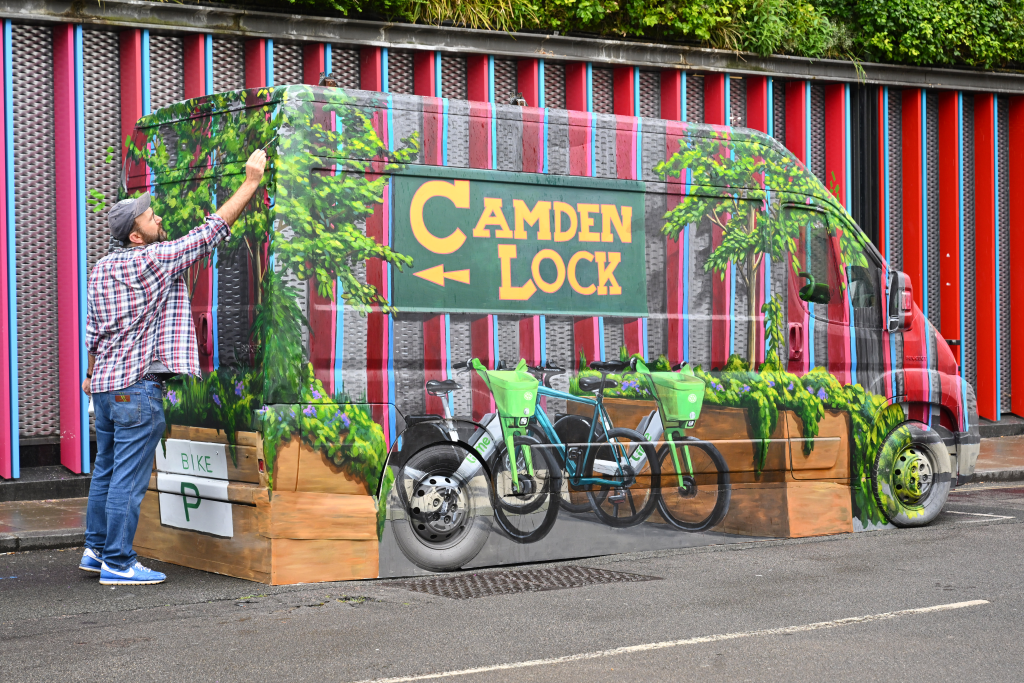-
New report written by Steer and supported by Centre for London reveals the UK capital is missing out on an estimated 30,000 emission-free journeys per day from rental e-bikes (>2% of total daily cycling trips in London), as demand exceeds space to park them
-
It outlines solutions for e-bike parking challenges and pavement clutter – such as the identification of over 750+ new potential parking locations
-
This includes recommendations to introduce standardised parking terminology, as well as establishing two different parking “zones” and rules for more-central and less-central London boroughs
-
The report is brought to life by an art installation from Lime and 3D street art pioneers, 3D Joe & Max to showcase the potential of greener, less car dominated urban spaces
Lime – the world’s largest provider of shared electric bikes and scooters – is encouraging Londoners to re-imagine how inner city street spaces could be repurposed to meet growing cycle demand and solve the capital’s e-bike parking challenges through a mind-bending illusion in Camden.
As Lime trip data shows an inner London borough like Camden now records approximately 200,000 Lime rides per month, the temporary art installation – designed by 3D street art pioneers, 3D Joe and Max – sees a non-ULEZ compliant 2007 Peugeot Boxer van with over 150,000 miles on the clock, magically transform into lush green space and bike parking as people walk past.
Lime is launching the artwork to bring to life recommendations from a new independent report by transport consultancy, Steer, and advised on by leading think-tank, Centre for London: ‘Changing Spaces: How to solve London’s shared e-bike parking’. It proposes potential solutions to the insufficient levels of parking locations and inconsistent parking requirements for rental e-bikes across London, as demand for the mode continues to grow exponentially.
It comes as almost half (49%) of Londoners aged 18-34 say they use a rental e-bike at least once a week according to polling in the report. Despite this uptick, Steer and Centre for London found London misses out on an additional 30,000 emission-free journeys each day – or >10 million per year – as a result of demand for e-bikes rising quicker than space is allocated to bike parking. Insufficient parking density and capacity can cause clutter on-street, with Lime recording a 21% increase in parking locations with exceeded vehicle capacity in Zone 1 on weekdays in the last six months. In response, the business has increased its on street staffing by 40%.
By comparison, London’s on-street car parking takes up space equivalent to 10 Hyde Parks, while 25% of London’s carbon emissions come from transport, and half of the city’s air pollution comes from road traffic, according to Centre for London. Polling for the report found that almost 1 in 3 London drivers (29%) leave their cars parked in public on-street locations when not in use, and more than a third (35%) use their vehicles for journeys better suited to green and active travel, under 1 mile.
The report recommends reallocating some of this space to cycle parking to help reduce car dominance and encourage greener travel, while ensuring London’s streets are tidy and free from pavement obstructions. As part of an initial audit it identified suitable spaces for at least 750+ new bike parking locations across 11 London boroughs, which could add parking capacity for up to 10,500+ additional rental e-bikes.
This included 163 new locations currently reserved for cars on carriageways or other open spaces that could fit 1,916 shared e-bikes. According to polling from the report, more than half (52%) of 18-34 year olds in London support the creation of more designated cycle parking spaces.
Hal Stevenson, Director of Policy for UK&I at Lime, said: “Demand for cycling, including Lime e-bikes, has skyrocketed in the last year, with more people opting for emission-free travel. This growth has come with unintended challenges, and it’s become clear that lack of parking is leading to overcrowded areas that can become obstructive for pedestrians. The report by Steer and Centre for London makes a number of clear recommendations to address this, which Lime is committed to taking.
“Our collaboration with 3D Joe & Max aims to bring these recommendations to life, and inspire a healthier use for London’s parking spaces, where cars often sit idle for days. We’re encouraging people to reimagine how public space could be used and to take action to make our streets better for people and the planet. As green, shared transport flourishes, we need to redesign our streets in ways that further encourage this adoption, and disincentive car usage, to meet London’s ambitious climate targets.”
Matthew Clark, Associate Director at Steer, said: “For the first time, this report outlines how much needed clarity and consistency on parking rules and increased parking provision for shared e-bikes can maximise the benefits of shared bikes and address current parking challenges. The report identifies where operators and boroughs can work together to improve the provision of parking for shared bikes across London, facilitating better parking by bike share users and transitioning from our car dominated urban realm. The report also highlights the opportunity to unlock significant additional demand for cycling across the capital, and the associated benefits this brings.”
Antonia Jennings, CEO at Centre for London, said: “E-bikes and similar micro-mobility vehicles are an essential part of the tapestry that is London’s sustainable transport. They are convenient, popular and produce far fewer pollutants than fully motorised vehicles. However, as our recent research into street clutter discovered, mis-parked micromobility vehicles can have a detrimental effect on pavement users – creating hazards for wheelchair users and those with visual impairments.
“Growing from our work on street clutter, this report begins to unpack best practice for micromobility services and their requirements from London Boroughs to provide sufficient, safely parked e-bikes and e-scooters. I look forward to the future collaboration this could bring between local government and private companies, working together to provide joined-up approaches to sustainable transport.”
Summary of report recommendations: solving London’s shared e-bike parking
Steer and Centre for London recommend the following measures to address the challenges associated with limited shared e-bike parking provision and support further growth of e-bike share in London:
-
Establish clear parking terminology to improve rider education – operators to work with boroughs to identify and implement London-wide standardised language for parking rules and permitted parking infrastructure. Operators will also consult on how this information can be displayed more clearly in-app through communications to improve education.
-
Single “Mandatory Parking Zone” to be established for more-central boroughs – a consistent approach to be adopted by all more-central boroughs reflecting high densities of destinations and volumes of trips. Boroughs to form a single “Mandatory Parking Zone” with “Mandatory Parking locations”, which is to be enforced when the following recommended parking densities are achieved: Highest demand zones: 50 parking locations/sq. km, Other high streets: 35 parking locations/sq. km, Residential: 25 parking locations/sq. Km.
-
Single “Flexible Parking Zone” to be established for less-central boroughs – a consistent approach to be adopted by all less-central boroughs. Boroughs to form a single “Flexible Parking Zone”, with “Mandatory Parking Locations” only implemented in high demand areas/high streets to reduce street clutter. Outside of these high demand areas users should be required to park considerately, and operators should enforce this using mandatory end trip photos.
-
Operators to support the increased implementation of “Mandatory Parking Locations” with trip data and funding – operators to support London Boroughs in the planning and implementation of “Mandatory Parking Locations” to meet demand, reallocate roadspace from the private car and establish a consistent density of parking locations. As part of this, Lime has launched a £1 million fund for parking infrastructure to help boroughs build more locations for shared e-bike parking around the city.
-
“Mandatory Parking Locations” to include underutilised public Cycle Stands – this will offer an immediate solution to parking challenges, while boroughs and operators work on delivering dense networks of carriageway bay parking, helping to reduce car dominance. The report found that currently, the average occupancy of personal bikes in Cycle Stands across audited locations was just 33% during daytime, and 28% in the evenings.
-
London-wide database of parking locations – to provide clarity and consistency for users, non-users, operators, TfL, Boroughs and Operators it is recommended that a consistent map database of Mandatory Parking Locations is developed and maintained to be used by all stakeholders.
Further campaign information
The ‘Changing Spaces’ art installation is available for the public to view in Camden between 29th-30th May at 17 Hawley Crescent in Camden from 10.30am – 5.00pm.
Those who support additional parking for bikes in London are encouraged to pledge their support for the campaign here.



